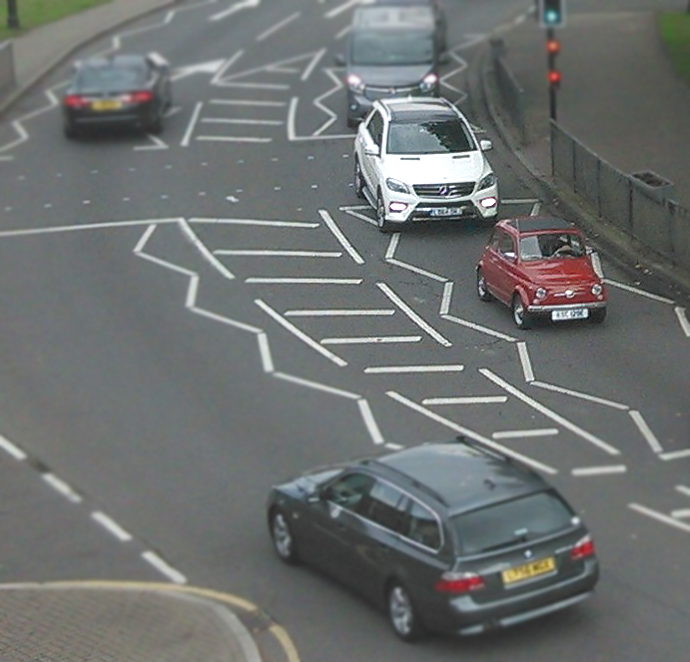
The size of a standard car parking space may be about to grow to keep pace with the ever-increasing width and length of cars.
The dimensions of a standard parking space were prescribed 50 years ago and over the last half century cars have become increasingly bloated. Safety features like side-impact bars have contributed towards the increasing size of cars, but a fashion for heavier, wider and taller SUVs has exacerbated the problem in recent years.

City cars like the original Fiat 500 are dwarfed by today’s SUVs
Cars are getting bigger. An appetite for creature comforts like air conditioning and electric windows has helped pile on the pounds, but it’s the car occupant safety features that have seen the family runabout become ever more tank-like. Everybody wants to remain safe on the roads, but the bigger and heavier the next car, the more robust your own vehicle needs to be. You need only look at how the original mini, or Fiat 500 or VW Golf have become bloated in their middle age. Unfortunately, the real losers are those outside the cars.
So serious is the threat from heavier cars – driven largely by the current fashion for SUVs – that The European Transport Safety Council (ETSC) has called for a ban on SUVs in towns and cities in a bid to cut cyclist and pedestrian fatalities. The risk of severe injury or death for a pedestrian is higher in collisions with Sport Utility Vehicles (SUVs) and vans compared to passenger cars because of the way they are designed: SUVs and vans are stiffer, they have higher bumpers and are heavier.”
Those welcoming calls for increasing the prescribed size for a standard parking space – which would also affect existing car parks – overlook one simple fact. Larger car parking spaces will result in fewer car parking spaces.
Bigger is not always better
When the German-British statistician and economist Ernst Schumacher said “Any intelligent fool can make things bigger, more complex, and more violent. It takes a touch of genius — and a lot of courage to move in the opposite direction“, he was making the case for human-scale, decentralised and appropriate technologies. It’s a shame car makers did not take note.
Sometimes referred to as a micro car, a quadricycle is a four-wheeled vehicle with an unladen mass not more than 400 kg (excluding batteries if it is an electric vehicle) and whose maximum continuous rated power does not exceed 15 kW.
There is a perception that large, heavy cars such as 4X4s are safe, but they pose an increased risk to pedestrian in the event of a collision. Quadricycles on the other hand are designed to operate in urban areas at low speeds and their low weight makes them less of a risk to pedestrians and less damaging to the road surface. In fact, in areas where people live and work, there’s a strong argument that any vehicle larger, heavier and faster than a quadricycle poses an unacceptable risk.
The ethical choice
The ETA was established in 1990 as an ethical provider of green, reliable travel services. Over 30 years on, we continue to offer cycle insurance , breakdown cover and mobility scooter insurance while putting concern for the environment at the heart of all we do.
The Good Shopping Guide judges us to be the UK’s most ethical provider.

Penny Price
I think that there should be special small sized car spaces for tiny cars, like smart cars, and fiat 500s. Two tiny cars can easily fit in the space of one normal car. These cars should also be exempt from carparking charges, after all they are using far fewer resources to get around, and this would further incentivise their use.
Michael Barnes
Surely the time has come for all built up urban area road traffic to be restricted to low emission vehicles, limited to an overall size and type, easily parkable in standard 5 x 2.5 metre bays. Vehicle size exceptions could be allowed for public transport, delivery and emergency vehicles using appropriate stopping spaces. This arrangement could be supplemented with separate parking areas for bicycles and mobility scooters preferably separated from the mainstream traffic.
Doug M
I have long thought that SUVs and other large cars and vans should be obliged to park in spaces furthest from the supermarket entrances. These spaces could be made slightly larger.
I also believe that it would increase safety if vehicles had to reverse into spaces in car parks, with a safe loading alley between parking rows. This would cut the danger of exiting from a space, since you have more chance to see what is coming over the front end of a car than over the often bulky rear end. The problem is compounded by the craze for dark tinted side windows.
Wendy
Hello Doug,
This is on my mind. Have you seen any guides about carparks to have small cars close to entrances, safe footpaths, bike/scooter lockers and SUVs furthest away?